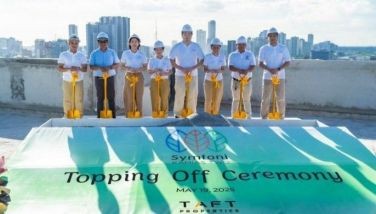Philippines on centerstage in Spain

MADRID – We could use some good news, for a change. For the first time in 134 years, the Philippines is back on centerstage in Madrid.
Backtrack to the year 1887 and Spain hosted the World Exposition. It will be recalled that Spain’s status as a colonial power was on a decline at this time. The Spanish crown intended to show the world that it was still a colonial force to be reckoned with. Thus, it featured the Philippines, its colony in the Far East, as the centerpiece of the exposition. The event was entitled, “Exposición General de las Islas Filipinas.”
Under the baton of Victor Balaguer, Spain’s colonial minister at the time, the Spanish government built the Palacio Cristal in Parque Retiro in Madrid. It was designed by architect Ricardo Velázquez Bosco with the intention of making it an architectural wonder to challenge the majesty of the Eiffel Tower. In it, they featured the people, culture, flora and fauna of the Philippines.
The event allowed Spain to flex its muscles as a colonial power. It was not quite the same for the Philippines. On display were the indigenous people of the Cordilleras (the Igorots) complete with their ethnic wear, straw houses, everyday tools and hand-made crafts. It depicted the Filipinos as a tribal society and the Spaniards as the agents of modernization.
The event failed to highlight the fact that the Igorots had a 2000-year-old civilization with its own form of government, societal hierarchy, agricultural technology, customs and traditions. Ancient Igorot engineering was so formidable that they built the Banaue Rice Terraces in the year 100 AD at 4,900 feet above sea level. Beneath the tiers of rice paddies is a complex irrigation system that channels water from nearby rainforests. It is among the few world heritage monuments that remain productive today (the great wall of China and the Pyramids of Egypt are considered dead monuments).
With the rice terraces providing food security, the Igorots were able to delve into lofty pursuits. They became masters in mining and also created songs, dances and sonnets to catalogue their history.
The depiction of the Igorots as an oddity enraged Jose Rizal. This prompted him to write numerous essays asserting that indigenous Filipino culture was just as sophisticated as that of the west, perhaps even better. He asserted that unlike western culture that extracted and pillaged the environment to support life, the Igorots co-existed with nature. There was harmony between the people and the environment – and both thrived side by side. The world would be in a better state today if the West took its cue from the Igorots.
In his writings, Jose Rizal submitted that Filipino talent could even beat the westerners in their own game. If not, Juan Luna’s Spoliarium and Felix Hidalgo’s Las Virgines would not have won the gold and silver prizes, respectively, in the 1884 Exposiciòn Mundial de Bellas Artes.
Jose Rizal’s assertions caused him to be labeled subversive. Our national hero endured immense persecution subsequently, culminating in his public assassination in 1896.
Fast forward to 2021 and the Philippines is again the main event at the Palacio Cristal. Thanks to Philippine Ambassador to Spain Philippe Lhuillier and Consul General Adrian Cruz, in cooperation with Spain’s Reina Sofia Museum, the Philippines gets to tell its version of history through an art exposition which opened last Oct. 29. The spectacle will be open for public view until March 2022.
Headlining the exhibition are the works of Igorot artist Kidlat Tahimik (Eric Oteyza de Guia), who is also a National Artist for Film. Kidlat is a product of UP and the University of Pennsylvania where he earned his masters in Business and Economics. He is also the founder of the AISEC business group in the Philippines. Although Kidlat’s business credentials are formidable, the artist in him dominated much of his professional life. Kidlat is an activist for Filipino culture, history and the environment.
Inside the cavernous Palacio Cristal are imposing art installations depicting Spanish colonial rule, told from the point of view of Filipinos. It is a departure from the accounts of Spanish scribe Antonio Pigafetta.
Kidlat’s art installations, made of wood and organic materials, depict how Filipinos had a well organized society, a functioning economy and a thriving agricultural industry even before the Spaniards arrived. Metalworks using steel, iron and gold were aplenty as well as irrigation systems in the villages.
Kidlat dispels the notion that our brothers in Mactan resisted Magellan’s army with mere tribal weapons. He says it only appeared that way since the entire kingdom, not only the warriors, came up in arms to defend their way of life. The warriors of Mactan were in fact daunting with sophisticated weapons and breastplates made of iron. Add to this their expertise in Arnis battle. He introduces a new character to the narrative, Bulakna, the better half of Lapu Lapu. Bulakna was beautiful, strong, intelligent and a cunning war strategist. Kidlat submits that it was Bulakna who dealt the fatal blow on Magellan, not Lapu Lapu. How shameful it would have been for the Spanish crown to admit that their lead conquistador was slain by a woman using Arnis sticks.
Another character is introduced in Kidlat’s life-size diorama, a man called Enrique de Malaca, the personal valet of Magellan. Judging from his name, it would appear that Enrique hailed from Malacca in Malaysia. Based on the accounts of Pigafetta, however, Enrique was fluent in Cebuano. Kidlat postulates that Enrique was actually born in Cebu and was traded as a slave to Malacca where Magellan picked him up.
Why is Enrique relevant? Because history claims that Magellan was the first person who circumnavigated the world. This is questionable, says Kidlat. Magellan started in Malacca, circumnavigated the world and died in Cebu. He covered the entire globe except the last 2,553 kilometers from Cebu to Malacca. Enrique, on the other hand, completed the journey. Hence, a Cebuano, in reality, was the first man to circumnavigate the globe.
It took us 134 years to tell our version of the story. In the context of history, it is a blink of an eye. We can all be proud that the Philippine narrative is told with conviction and flair in the land of our colonizers. How benevolent is the Spanish government and Reina Sofia Museum for funding the event.
* * *
Email: andrew_rs6@yahoo.com. Follow him on Facebook @Andrew J. Masigan and Twitter @aj_masigan
- Latest
- Trending






























